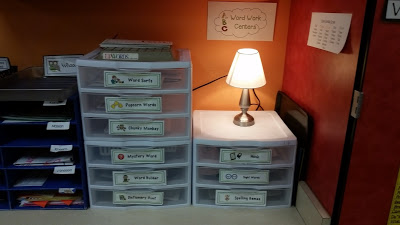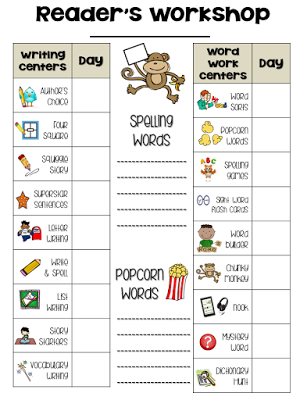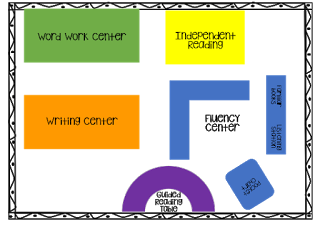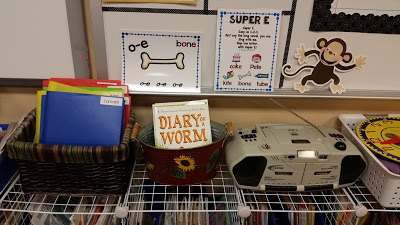I have a passion for Guided Reading and Literacy Centers. Truly, they are the backbone of my classroom instruction – the meat-and-potatoes of my first grade curriculum. Some things can be skipped or pushed to the next day, but not these key components. The structure and routine we have built are crazy important to me.
The way I run these key components reflect my true beliefs about how children learn. I strive to make these things a priority when planning and designing lessons and activities for centers.
LITERACY CENTERS SHOULD BE STRUCTURED.
Maybe some teachers can handle students working on different things each day while they randomly call groups back to the guided reading table, but not me. That type of system just doesn’t work for me. I need a structured routine that enables students to know exactly what they are doing now, and what comes next, at all times.
We follow a predictable schedule Monday-Friday.
I have five reading groups based on their reading level, and they stick together through all 5 literacy centers every day.
In our classroom, our literacy centers are structured in a very intentional way to support student engagement, learning, and the needs of our learners. Students rotate through all the centers every day in a clock-wise motion.
Working in the Fluency Center gets students “warmed up” and ready to read in the Guided Reading Center.
Each week in Guided Reading, we have a Reader’s Response that requires writing, so students frequently finish it up in the Writing Center (right after guided reading).
Guided Reading is the noisiest center since we discuss what we are reading, so it is placed on the opposite side of the classroom from Independent Reading (so those readers can have as much peace and quiet as possible to concentrate.)
As you can see, a lot of thought went into the planning of our center rotation and the location of each of the centers in our classroom.
Each group starts in the same center each day, so their routine is predictable and my groups follow the same sequence at the guided reading table (important because of some students’ pull-out times for Title One reading, ELL, Speech, and other special support). I need to get these students to my guided reading table each day, even if they miss other centers.
Guided Reading is a non-negotiable in my class, and my centers routine is scheduled in a way to make that possible for every student, no matter their special out-of-the-classroom needs.
LITERACY CENTERS SHOULD BE PURPOSEFUL.
Each center has a purpose- an important purpose in Balanced Literacy. All of the activities in each center provide a special emphasis in some type of literacy practice. I have multiple options available for writing, word work, and fluency practice because there are so many facets of each of these elements. I want to make sure I am addressing all of the skills needed to be successful readers, writers, and thinkers.
LITERACY CENTERS SHOULD BE ENGAGING.
Students love to work in centers when they are fun and engaging. Sometimes it is the little things that make an activity fun for a six-year old. Practicing writing spelling words is okay, but writing spelling words on rainbows with skinny markers is way more fun! I try to find engaging center ideas so students will want to stay on task and complete their practice or inquiry.
LITERACY CENTERS SHOULD ALLOW FOR DIFFERENTIATION.
When an activity meets a child’s needs, magic happens. The truth of the matter is…..all of our students have different needs! They come to us with such a wide variety of experience, exposure, interests and skills that it is unlikely that one activity will meet everyone where they need to be.
I make sure students of every level will be engaged with SOMETHING in each center- they have many choices because their interests and skill levels are so vastly different.
For example, my lower students really enjoy the simple word work that allows them to use different tools to make their sight words (water painted on chalkboards, playdough, salt trays, etc.), but my higher students are much more engaged with Mystery Words or Dictionary Hunts- the skill levels are widely different because my students have different needs.
 |
| Drawers for the Word Work Center |
 |
| Drawers for the Writing Center |
LITERACY CENTERS SHOULD REQUIRE ACCOUNTABILITY.
Each center has multiple recording sheets so that I can see what they’ve been working on during their center time. There are a few centers that don’t require a recording sheet, though. I have students use the paper below in their Center Folder each week.
 |
| Our Weekly Center Paper |
On Monday before center time, students practice writing their spelling words, sight words, and phonics chunk, then through the week they write an M, T, W, Th, or F in the box next to a center when they complete it. That tells me which center they did on which day. They also keep all of their work and recording sheets in the folder all week.
Students know they need to complete a variety of activities in each center to become great readers and writers. They should only do a center once a week so they can become well-rounded. I do want them to be able to continue working on an activity another day if they need to, though, so I allow a little flexibility in that area.
On Friday afternoon, I unpack all of the papers from their center folders and peek at their work from the week before stapling them together and sending them home.
If I need to have a conversation with a student about completing work, choosing a variety of centers, or documenting their learning in a meaningful way, I pull them aside on Friday before sending home their work. I also usually write a quick note on their center paper to remind them what we discussed (and alert parents to their child’s focus or goal for the next week).
I also love to pull a few examples of quality work for Monday’s sharing time. I display their center work proudly and point out the extraordinary details they used in their writing, neat handwriting efforts, or the care they took to completely finish a difficult task.
If there is a center that is being overlooked or only given half-efforts by multiple students, I’ve found that this is a great way to re-motivate students to really engage with this activity. If students still struggle with the center after that, I may need to re-think the activity and its appropriateness. Singling out quality work usually does the trick, though.
THANKS FOR READING!
Join me next time for how we get our centers started at the beginning of the year!




Leave a Reply